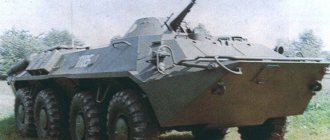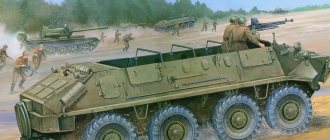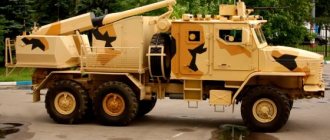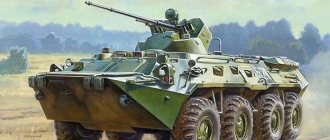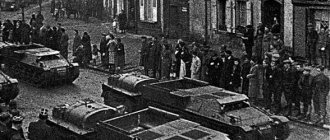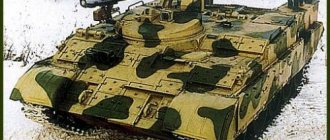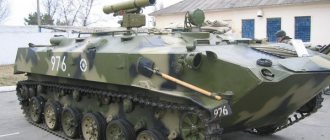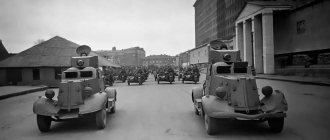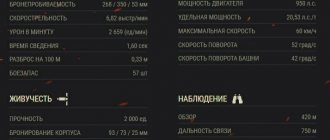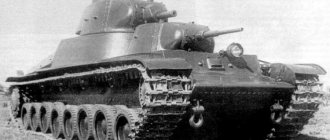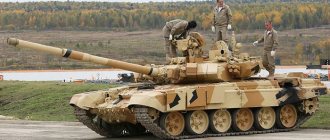From the beginning of the Second World War until its end, the Sd.Kfz.251 half-track armored personnel carrier was a constant companion of the German troops. This image is formed by movies, where German soldiers are necessarily armed with MP-38/40 submachine guns and move in armored vehicles (in Soviet cinema, their role is played by the BTR-152, which has a characteristically chopped hull shape).
The Sd.Kfz.251 armored personnel carrier is often called the “Hanomag”, although this designation is erroneous. The car was developed by another and was only one of the armored car manufacturers. The company is known for a range of automobiles and tractors. One of the most popular models was the minicar Hanomag2/10 PS Kommisbrot, built in significant numbers in the 20s. No less famous is the Hanomag WDZ 50 tractor, which served as the prototype for the Soviet Kommunar tracked vehicle.
History of creation
The development of armored vehicles intended for transport and fire support of infantry began in Germany in the mid-30s. The prototype of the future Sd.Kfz.251 machine under the designation Hl6 was created by Hansa-Lloyd, which was part of the Carl FWBorgward concern. A little later, the license for the right to produce the chassis and armored hull was purchased from Hannover.
In 1938, Borgward, and then Hanomag, produced the first chassis for the new armored personnel carrier. The basis was the platform of the half-track artillery tractor Sd.Kfz.11, which by that time was being built in series. The prototypes were tested under the designation HKL6p. By the end of the year, armored personnel carriers of the so-called 0-series appeared. The vehicle received the classification of a medium armored personnel carrier - mitteler gepanzert Mannschaftstransportwagen (MTW). According to the classification of the Armament Directorate, the vehicle was assigned the index Sd.Kfz.251.
The assembly of serial Sd.Kfz.251 vehicles began in the summer of 1939 at the Deutsche Werke (Kiel) and Borgward (Bremen) factories.
At the same time, welded hulls made of armor or ordinary structural steel were produced in parallel. Both types of vehicles entered service with Wehrmacht infantry units and took part in battles in Poland. As output increased, other firms began to be involved in production. So, at the beginning of 1941, the Czech plant in Böhmisch Leipa, which assembled riveted armored hulls, joined the production of vehicles.
Subsequently, the assembly of armored vehicles was carried out by at least 10 enterprises located on the territory of the Third Reich. Among them are Gollnow, Weserhuette, Wumag, Hanomag, MNH, and Schichau. Due to the large number of manufacturers, Sd.Kfz.251 armored personnel carriers of the same production period differ in various elements, such as roller tires, structural elements of the front wheels, tracks, etc.
Use [edit]
The first production samples of this vehicle entered the 1st Tank Division in 1939.
These vehicles were supposed to allow panzergrenadiers
accompany tanks and, if necessary, provide support to infantry.
In practice there were always not enough of them, and most tank
units had to make do with trucks for transport. [4]
In August 1943, Romania acquired 27 armored half-track vehicles, both 251 and
and
250
types [5], and in 1944, 251 armored cars and other types of armored cars to convert the two cavalry divisions into armored or mechanized ones. [6]
The army from the Independent State of Croatia received 15 Sd.Kfz. In the spring of 1944 - 251, and in the autumn of 1944 the Ustasha militia - 12 [7].
Modifications
To designate modifications of German armored vehicles, the term Ausführung is used - model, followed by the letter designation of the version. The first version of the Ausf.A armored personnel carrier is easily distinguished by additional viewing devices located on the upper part of the fighting compartment hull. The Notek antenna and headlight were located on the wing of the car.
On the subsequent model Ausf.B, the number of viewing devices was reduced; only the driver and radio operator had them. The antenna was moved to the top sheet, in the area of the radio operator's workplace. The Notek headlight received a bracket mounted on the upper side sheet of the engine compartment of the car.
Production of the new version C, differing in the design of the frontal part of the hull, began in 1940. Moreover, at this moment several new enterprises joined the production (at least Schichau and MNH).
https://www.youtube.com/watch?v=8xG1cVB6OY4
But in parallel there was a production of cars and previous versions, which ended only in the middle of next year. For armored personnel carriers of version C, a characteristic external feature is a blank flat frontal sheet of the engine compartment and armored casings for hot air exhaust channels located on the sides of the hood. The latest modification, Ausf.D, began production in the fall of 1943.
The machine is distinguished by an extended hull (welded construction only) with a flat inclined stern sheet. The new Sd.Kfz.251 hull consisted of fewer parts and was easier to manufacture, which made it possible to increase production. In total, more than 10.6 thousand Ausf.D units were assembled; for comparison, the total volume of previous modifications of the armored personnel carrier was 4.65 thousand vehicles.
Based on basic modifications, 23 versions of the Sd.Kfz.251 were produced. Moreover, some versions could use several chassis, and some were mounted on the basis of only a late modification of the Ausf.D armored personnel carrier.
Serial options:
- 251/1, the standard version for transporting 10 infantrymen, is armed with one or two MG34 or 42 machine guns equipped with an armored shield;
- 251/2, a version designed to mount an 8 cm mortar and carry 66 rounds of ammunition;
- 251/3, an armored personnel carrier equipped with additional radio stations (communication vehicle);
- 251/4, a variant used to transport field howitzers, crews and a small supply of shells;
- 251/5, an early sapper version of the vehicle;
- 251/6, an armored personnel carrier adapted for use as a command post for large army units;
- 251/7, late sapper version, supplemented by assault bridges on the sides of the hull;
- 251/8, an ambulance, was distinguished by its coloring with a red cross;
- 251/9, assault version with a short-barreled 75 mm KwK 37 or K51 gun (analogous to that used on early PanzerIV);
- 251/10, version with reinforced weapons (37 mm Pak 36 anti-tank gun with a standard shield shortened in height or PzB 39 anti-tank gun);
- 251/11, telephone cable layer;
- 251/12, command vehicle version for artillery units;
- 253/13 and 251/14, rare variants designed for sound reconnaissance;
- 251/15, reconnaissance photometric vehicle version;
- 251/16, the armored personnel carrier is additionally equipped with two flamethrowers, a mixture tank and a motor pump;
- 251/17, mounted 20 mm Flak 38 anti-aircraft complex, differs in the design of the hull sides;
- 251/18, communications and observation armored vehicle;
- 251/19, mobile telephone point;
- 251/20, an armored personnel carrier with the installation of an infrared searchlight to illuminate targets;
- 251/21, an anti-aircraft version of the vehicle with the installation of three MG151 guns (with barrels of 15 or 20 mm caliber);
- 251/22, self-propelled gun with Pak40 anti-tank gun;
- 251/23, option with the installation of a Hangelaffete 38 rotating turret with a pair of MG151 cannon and MG42 machine gun.
In addition to the Sd.Kfz.251 armored personnel carriers listed above, there were front-line handicraft designs made in single copies.
Design
The Sd.Kfz.251 vehicle is based on a frame chassis on which an armored hull is installed. The hull is built on the basis of a frame to which armor plates are welded or riveted. Regardless of the type of connection, heterogeneous armor was used. The frontal sheets had a thickness of 10...15 mm, the side and rear sheets had a thickness of 8 mm, and a sheet with a thickness of 6...8 mm was used for the bottom.
Frontal armor provides relative protection against small arms fire. There is a 6 mm thick roof only over the heads of the driver and radio operator. In bad weather, a canvas awning on arches could be installed over the combat compartment of an armored personnel carrier.
The Sd.Kfz.251 body includes an engine compartment, behind which is the fighting compartment. There is a steel bulkhead between the engine and the compartment. At the beginning of the combat compartment of the armored personnel carrier there are seats for the driver and radio operator. On some cars there is a foot heating system, which is a pipe for supplying warm air from the engine compartment.
The rear of the car is unheated. The layout of the fighting compartment differs depending on the purpose of the vehicle.
The power unit was an in-line 6-cylinder carburetor MaybachHL 42 TURKM engine. The engine had a power of 100 hp. with a cylinder displacement of 4117 cubic meters. see. The motor is located in front of the armored personnel carrier in a compartment protected by armor. The radiator of the cooling system is installed in front of the engine, air is taken in by fans from under the car.
On early versions of the Sd.Kfz.251 there was a ventilation hatch on the front plate and a grille on top. There were shutters in front of the radiator that controlled the cooling intensity. The fuel capacity is 160 liters; the tank is located inside the frame under the floor of the fighting compartment.
The Sd.Kfz.251 machines used a dry-type double-disc clutch and a planetary transmission, providing four forward gears and one reverse gear. The box had an additional gear ratio increaser, which was used when driving off-road. The armored personnel carrier turned around using the steered wheels of the front axle and adjusting the power flow supplied to the tracks.
The armored personnel carrier does not have additional final drives or clutches. The differential control was automatic and was activated when the car's wheels were turned to a certain angle. Air brakes were used for stopping.
The tracked part of the Sd.Kfz.251 vehicle is equipped with a torsion bar suspension of rollers arranged in a staggered pattern. Due to the installation of torsion bars, the left and right side rollers are shifted relative to each other by 140 mm. Because of this, an additional link was used in the starboard track (55 and 56, respectively).
The drive wheel is located in the front part of the mover, the rear one is equipped with a crank for adjusting the tension of the caterpillar track. The armored personnel carrier's track itself is made up of small links (connected by pins on needle bearings), equipped with rubber pads on the outside.
The front axle is equipped with a transverse swing spring and additional lever shock absorbers.
The bridge is equipped with pneumatic tires. On early cars there were tires with a road tread pattern, later off-road tires began to be used.
Specifications
The performance characteristics of the Hanomagov ensured their high maneuverability.
The technical characteristics of the SdKfz 251 made it possible to ensure the mobile transfer of soldiers to the front line. The vehicle overcame slopes of up to 24 degrees, two-meter ditches and fords up to half a meter high. The armored personnel carrier's high maneuverability and the effectiveness of the tactics used ensured its mass production - 15,252 vehicles were assembled during the war years.
Dimensions and weight
In terms of dimensions, the Hanomag had the following characteristics:
- weight - 9.14 tons;
- body length - 5.98 m;
- width - 2.1 m;
- height - 1.75 m;
- track - 1.775 m;
- ground clearance - 0.32 m.
The SdKfz 250 model was distinguished by reduced dimensions - the weight was reduced to 5.8 tons, and the dimensions of the vehicle were also reduced. This reduced the number of soldiers transported, but improved the driving properties of the armored personnel carrier. This model was produced for highly specialized tasks and the rapid transfer of small groups of soldiers. A total of 7,326 of these machines were produced.
Speed
The SdKfz 251 armored personnel carrier reached speeds of up to 50 km/h on the highway. The power reserve was up to 300 kilometers. The lightweight SdKfz 250 model could reach a speed of 60 km/h and a range of 320 km.
Engine power
Both Hanomag models used the same liquid-cooled Maybach HL 42 TURKM six-cylinder carburetor engine. Its power was 100 hp. s., specific power - 10.9 l. s./t.
Crew
The crew of both Hanomag models consisted of two people - a driver and a commander. The difference in size and configuration affected the number of soldiers transported - 4 and 10 people for the SdKfz 250 and SdKfz 251, respectively.
Application in battles and comparison of parameters
Sd.Kfz.251 armored personnel carriers were actively used by Wehrmacht and SS formations in combat operations. If at the early stage of the Second World War the vehicle served to deliver infantry units, then at the time of the invasion of the USSR the armored vehicle was used both as a field artillery tractor and as an ammunition carrier.
Command armored personnel carriers based on the Sd.Kfz.251, equipped with loop antennas and an additional set of radio stations, have become widespread. At the end of the war, assault and anti-tank guns began to be installed on the basis of armored personnel carriers.
Such vehicles were not successful in battle due to weak protection and overweight construction.
A comparison of the German Hanomag car and the most common American analogue M3 (more than 31 thousand copies built) shows the similarity of parameters. The American is distinguished by its increased body height, which is why the car was more noticeable.
| Parameter | Sd.Kfz.251Ausf. C | M3 |
| Combat weight, kg | 9140 | 8980 |
| Length, mm | 5980 | 6130 |
| Width, mm | 2100 | 1962 |
| Height, mm | 1750 | 2260 |
| Ground clearance, mm | 320 | 280 |
| Troops, people | 10 | 10 |
The M3 vehicles had a similar armor scheme and a gasoline engine; they were equipped with mortars and anti-aircraft weapons, as well as 75 mm and 105 mm howitzers. American armored vehicles remained in service in a number of countries until 2013.
Despite the design flaws, the Sd.Kfz.251 armored personnel carrier made it possible to provide rapid movement of infantry units and fire support on the battlefield. Soon, the experience of using the technology began to be adopted by the opposing side, but mass production of such machines began in the post-war years. The popularity of the German car was so great that after the war, production of a modernized version of the OT-801 began in Czechoslovakia at the Tatra plant.
Individual copies of the machines were used in the Czechoslovakian army until the end of the 70s. Czech vehicles are often passed off as original armored personnel carriers during reconstruction, but they are easily identified by their drive wheel and lantern track.
As for, after the war it came under the wing of Mercedes-Benz.
The brand was renamed Hanomag-Henschel; similar front-wheel drive vans and trucks were in the production program until 1974. Today, the designation “Hanomag” is used for road equipment by Komatsu Hanomag GmbH.
The lineup
"Hanomag" SdKfz 251
The German armored personnel carrier Hanomag SdKfz has two main models with numbers 250 and 251. The first version is lightweight and was used in limited quantities. The second sample has become widespread and has many of its own modifications.
SDKfz 250
SdKfz 250 was put into mass production later than version 251, becoming its lightweight copy. This model was distinguished by smaller dimensions, weight and carrying capacity. It was used to transport small groups of soldiers, and was often used as a support vehicle, for example, as a communications center.
The layout, design, engine - all this was retained from the SdKfz 251. However, the design was simplified and reduced. The model itself also received a number of modifications, designed for various applications at the front - from an infantry support vehicle to reconnaissance.
SDKfz 251
The SdKfz 251 is a heavy half-track armored personnel carrier developed on the basis of a three-ton artillery tractor. The main task of the vehicle is to transport infantry. If necessary, it could be used for other purposes, up to the deployment of command headquarters.
This model has received a significant number of modifications. Among them are the designations Ausf. A, B, C and D, used to highlight design differences. Based on them, 23 specialized modifications have been developed, designed to solve narrow-profile problems.
